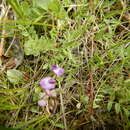Comprehensive Description
provided by North American Flora
Phaca yukonis (M. E. Jones) Rydberg
Astragalus Yukonis M. E. Jones, Rev. Astrag. 89. 1923.
Perennial, with a slender, cespitose rootstock; stems filiform, decumbent at the base, 1-2 dm. high, sparingly pubescent; leaves 2-5 cm. long; stipules deltoid, 1-3 mm. long; leaflets 5-13, elliptic, 4-7 mm. long, obtuse or retuse at the apex, glabrous above, sparingly strigose beneath; peduncles about 1 dm. long; racemes at first short, elongate in age, 2-6 cm. long; bracts deltoid, scarious, 2 mm. long; pedicels 1-1.5 mm. long; calyx black-hairy, the tube 2.5 mm. long, the teeth deltoid-subulate, fully 1 mm. long; corolla purple, 7-8 mm. long; banner obovate, moderately arched; wings shorter, the blades oblong, rather strongly falcate; keelpetals still shorter, the blade strongly lunate, rounded at the apex; pod ellipsoid, about 7 mm. long, 4 mm. broad, black-hairy with short hairs.
Type locality: Ranch Valley, Fort Selkirk on the Yukon.
Distribution: Yukon.
- bibliographic citation
- Per Axel Rydberg. 1919. (ROSALES); FABACEAE; PSORALEAE. North American flora. vol 24(1). New York Botanical Garden, New York, NY
Comprehensive Description
provided by North American Flora
Phaca prebblei Rydberg, sp. now
Perennial, with a rootstoek; stems slender, 2-3 dm. long, prostrate or decumbent, sparingly hairy; leaves 3-5 cm. long, spreading; stipules ovate, 3 mm. long; leaflets 13-17, elliptic or oblong, 4-15 mm. long, acute at the base, obtuse or more often slightly emarginate at the apex, glabrous above, sparingly strigose beneath; peduncles 7-12 cm. long; racemes 3-5 cm. long, rather lax; bracts lanceolate, 2 mm. long; pedicels 1 mm. long; calyx black-hairy with short hairs, the tube 3 mm. long, the teeth subulate, 1 mm. long; corolla purplish, about 10 mm. long; banner broadly obovate, retuse, rather strongly arcuate; wings shorter, the blade obliquely oblanceolate, falcate, with a reflexed auricle; keel-petals still shorter, the blade broadly lunate; pod obliquely elliptic-ovoid, 1 cm. long, 3-4 mm. wide, white-strigose, the upper suture nearly straight.
Type collected on the Athabasca River. Alberta. August 14'. 1903, Prebble &■ Cary 123 (U. S. Nat. Herb. 421630).
Distribution: Alberta and Mackenzie.
- bibliographic citation
- Per Axel Rydberg. 1919. (ROSALES); FABACEAE; PSORALEAE. North American flora. vol 24(1). New York Botanical Garden, New York, NY
Comprehensive Description
provided by North American Flora
Homalobus retusus Rydb. Bull. Torrey Club SO: 186. 1923
A perennial, with a slender cespitose rootstock; stems decumbent or ascending, 1-2 dm. long; leaves 5—8 cm. long; stipules lanceolate or the lower ovate or triangular, connate, 1-2 mm. long; leaflets 9-11, oblong to oval, often retuse or emarginate, 5-12 mm. long, 2-4 mm. wide, glabrous above, sparingly strigose beneath; peduncles 6-10 cm. long, slender; racemes short, 5-10-flowered; bracts lanceolate, 2 mm. long; calyx black-hairy, the tube 2 mm. long, the teeth subulate, 1 mm. long; corolla purplish; banner 8-9 mm. long, obovate; wings 7-8 mm. long, the blade obliquely oblanceolate, with a long basal auricle; keel-petals slightly shorter, with a rounded apex; pod black -hairy, sessile, S mm. long, 3.5 mm. wide.
Type locality: Fort Selkirk, Yukon. Distribution: Yukon and Mackenzie territories.
- bibliographic citation
- Per Axel Rydberg. 1919. (ROSALES); FABACEAE; PSORALEAE. North American flora. vol 24(1). New York Botanical Garden, New York, NY
Physical Description
provided by USDA PLANTS text
Perennial, Herbs, Stems woody below, or from woody crown or caudex, Taproot present, Nodules present, Stems or branches arching, spreading or decumbent, Stems prostrate, trailing, or mat forming, Stems less than 1 m tall, Stems solid, Stems or young twigs glabrous or sparsely glabrate, Stems or young twigs sparsely to densely hairy, Leaves alternate, Leaves petiolate, Stipules conspicuous, Stipules membranous or chartaceous, Stipules persistent, Stipules connate to each other, forming a tuber or sheath, Leaves compound, Leaves odd pinnate, Leaf or leaflet margins entire, Leaflets opposite, Leaflets 10-many, Leaves hairy on one or both surfaces, Inflorescences racemes, Inflorescence axillary, Bracts very small, absent or caducous, Flowers zygomorphic, Calyx 5-lobed, Calyx glabrous, Petals separate, Corolla papilionaceous, Petals clawed, Petals blue, lavander to purple, or violet, Banner petal narrow or oblanceolate, Wing petals narrow, oblanceolate to oblong, Wing tips obtuse or rounded, Keel petals auriculate, spurred, or gibbous, Keel tips obtuse or rounded, not beaked, Stamens 9-10, Stamens diadelphous, 9 united, 1 free, Filaments glabrous, Style terete, Style persistent in fruit, Fruit a legume, Fruit stipitate, Fruit unilocular, Fruit tardily or weakly dehiscent, Fruit oblong or ellipsoidal, Fruit exserted from calyx, Fruit inflated or turgid, Fruit beaked, Fruit hairy, Fruit 3-10 seeded, Seeds cord iform, mit-shaped, notched at one end, Seed surface smooth, Seeds olive, brown, or black.

